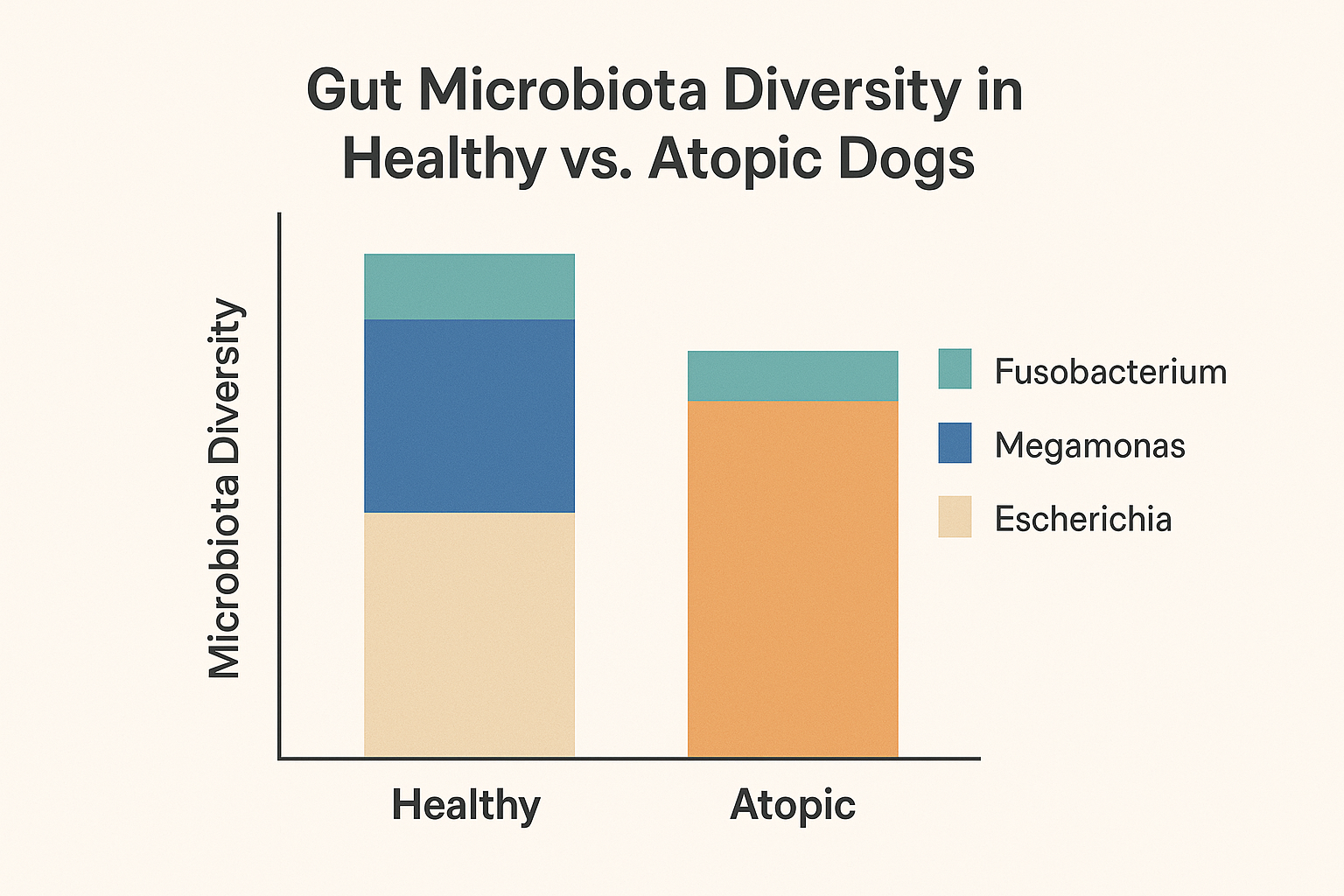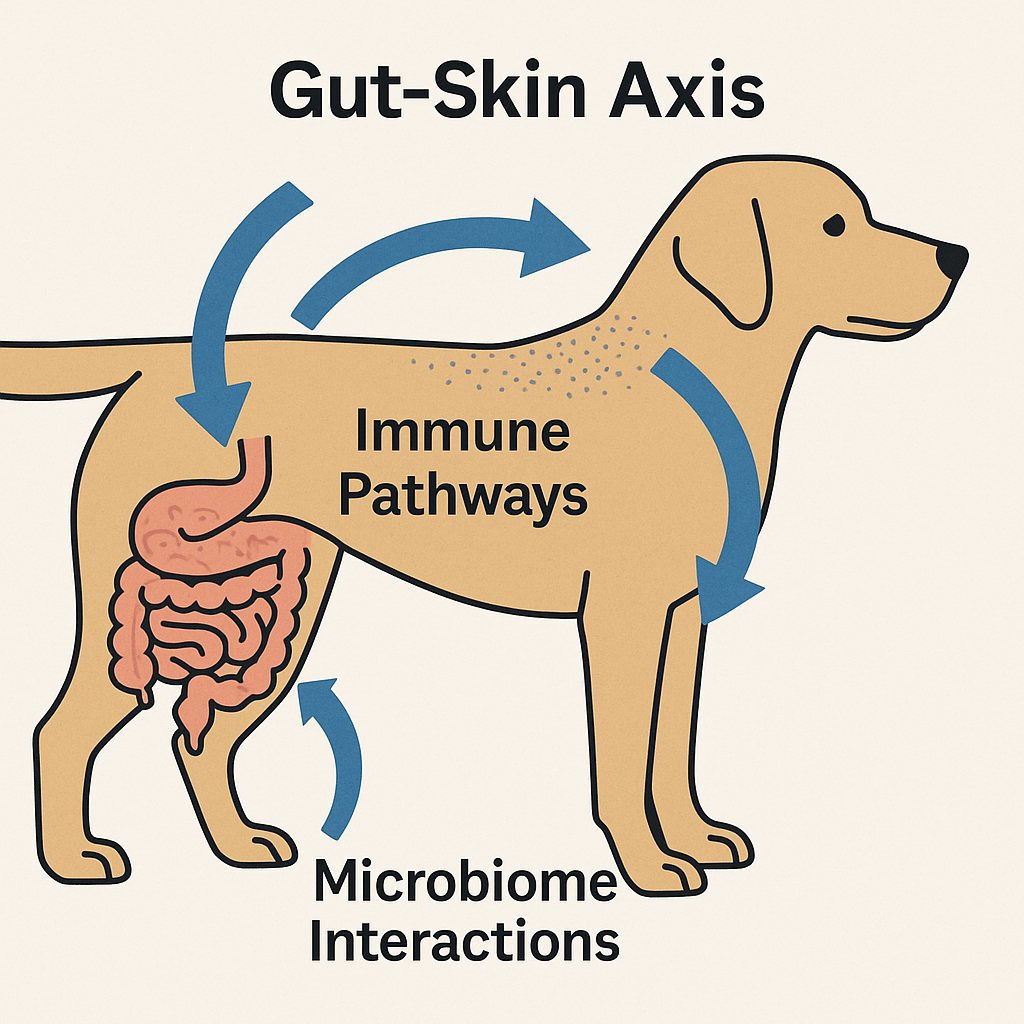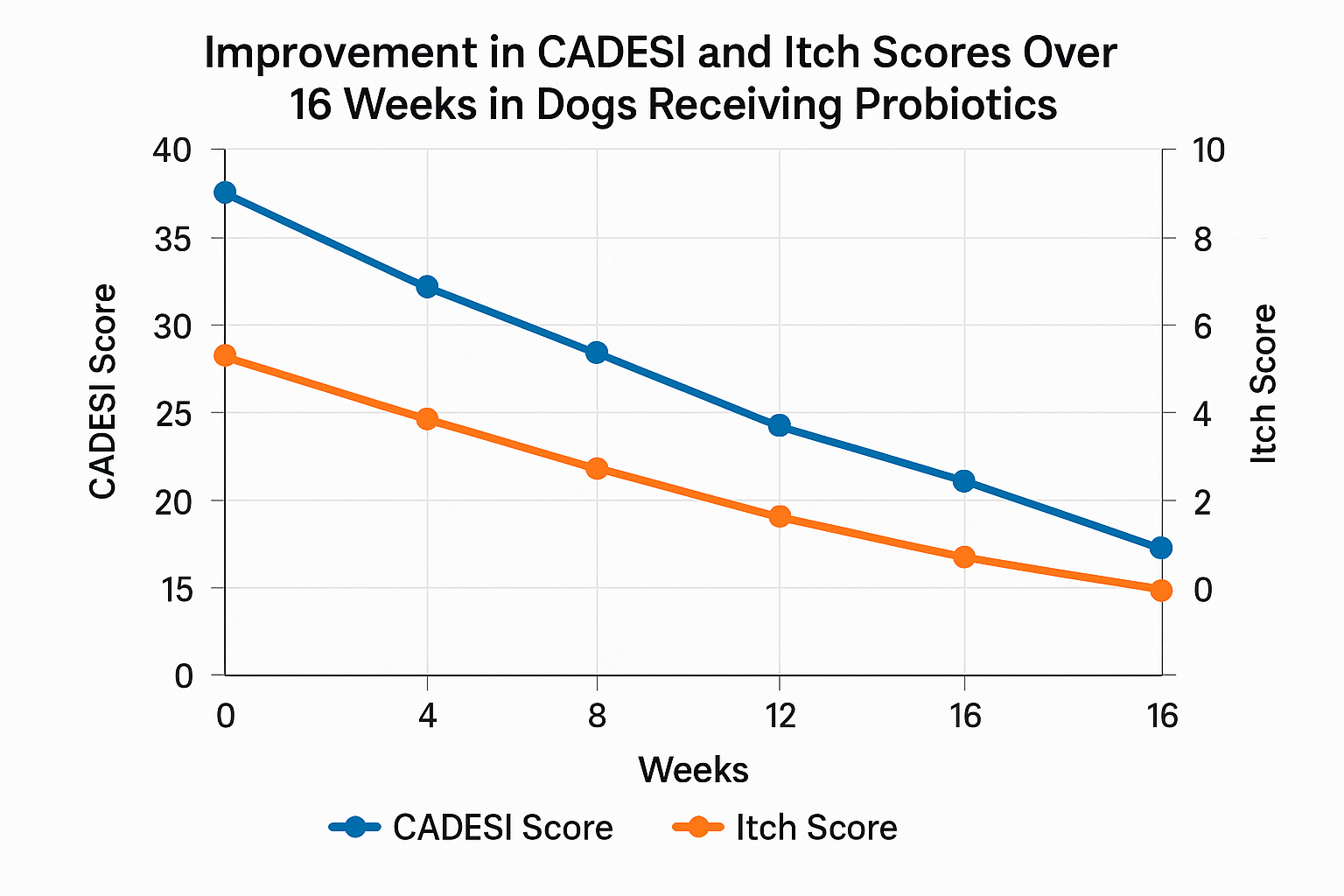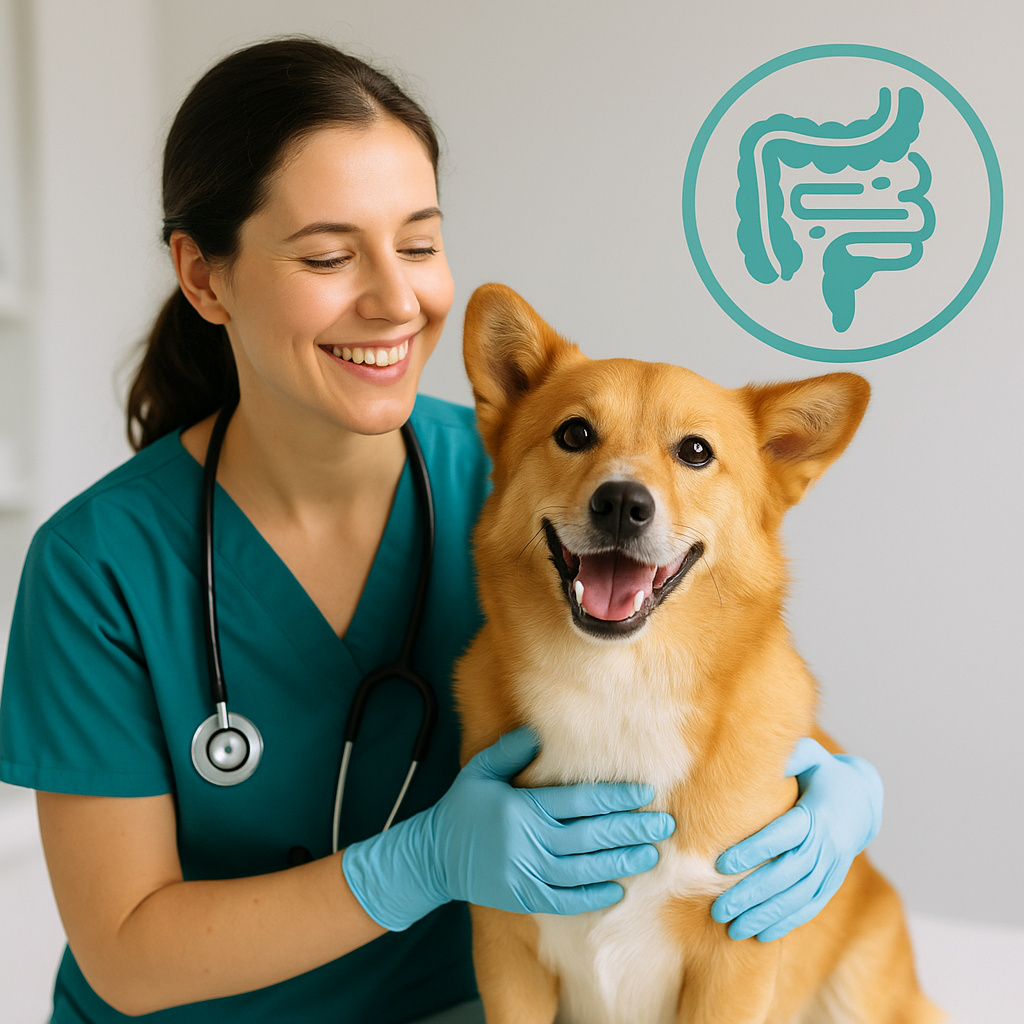Medical Disclaimer:
This article is intended for informational purposes only and should not be considered a substitute for professional veterinary advice, diagnosis, or treatment. Always consult your veterinarian for personalized guidance regarding gut health and skin conditions in dogs or any other medical concerns.
Table of Contents
Introduction
As a small-animal veterinarian, I’ve treated hundreds of dogs suffering from persistent itching, chronic ear infections, and inflamed, irritated skin. Many of these patients have been on antihistamines, medicated shampoos, or even prescription allergy medications, yet their symptoms keep coming back. Over time, I began noticing a trend: some of the most stubborn skin cases also had recurring gastrointestinal issues, soft stools, gas, and food sensitivities. That’s when I started paying closer attention to the gut.
It turns out I wasn’t imagining things. A growing body of veterinary research now confirms that gut health and skin conditions in dogs are deeply connected. When the gut microbiome, home to trillions of beneficial and harmful bacteria, is out of balance, it can disrupt immune regulation, trigger inflammation, and make the skin more reactive to environmental or dietary allergens. In clinical practice, this means that treating the gut can sometimes lead to better outcomes than topical therapies alone.
We’re entering a new phase of dermatologic care where microbiome-focused treatments like targeted probiotics, dietary modulation, and immune-modulating drugs are being used not just for digestive problems, but also to improve skin health. And while more research is still needed, the data so far is promising: by supporting a healthier gut, we may be able to significantly reduce itch, redness, and infection rates in allergic dogs.
In this article, we’ll explore what the latest studies reveal about gut health and skin conditions in dogs, how this knowledge translates into real-world treatment strategies, and what you, as a pet owner or clinician, can do to help restore balance from the inside out.
🐾 Key Takeaways
- Gut health and skin conditions in dogs are closely linked, especially in cases of canine atopic dermatitis (cAD).
- Dogs with skin allergies often have gut dysbiosis, including reduced levels of beneficial, anti-inflammatory bacteria like Fusobacterium and Megamonas.
- Treatments like probiotics and oclacitinib can shift both gut and skin microbiomes toward healthier profiles.
- Diets rich in prebiotics, omega-3s, or novel proteins may improve skin symptoms by supporting gut diversity.
- Research is ongoing, but incorporating gut-targeted therapies offers promising results in reducing chronic itching, inflammation, and flare-ups.
The Link Between Gut Health and Skin Conditions in Dogs
For years, veterinary dermatology focused primarily on topical treatments, antibiotics, and immunosuppressants to manage skin conditions in dogs. However, recent advances in microbiome science have revealed that many chronic skin issues stem from internal imbalances, particularly in the gut. This emerging understanding has reshaped how we view the relationship between internal health and external symptoms.
The gut and skin are both heavily involved in immune regulation, and when one is inflamed or imbalanced, it often impacts the other. Dogs with allergic skin disease frequently show signs of gastrointestinal issues such as loose stool, flatulence, or food sensitivities. These signs can indicate gut dysbiosis, a state where harmful bacteria outnumber beneficial species, reducing microbial diversity and weakening the gut’s ability to regulate the immune system effectively.
Research now supports what many veterinarians have observed in practice: gut health and skin conditions in dogs are deeply interwoven. Disruptions in gut bacteria not only compromise digestion but also alter systemic immune responses, increasing the likelihood of skin inflammation, pruritus, and secondary infections.
By restoring a healthy gut microbiome through strategic use of probiotics, anti-inflammatory diets, or immune-modulating therapies, we can support both gastrointestinal and skin health. This holistic approach is essential for managing gut health and skin conditions in dogs, especially those suffering from atopic dermatitis or recurrent infections that don’t fully respond to traditional therapies.
Understanding the Research
You can also visit: https://doglifeexpert.com/7-natural-remedies-for-dog-skin-allergies/

How the Gut Microbiome Differs in Atopic Dogs
Multiple studies now show that gut health and skin conditions in dogs are deeply intertwined. In one comparative study of healthy and atopic dogs, researchers found that allergic dogs had significantly lower alpha diversity, a measure of microbial richness and balance in their gut microbiome. Healthy dogs had higher populations of beneficial bacteria like Fusobacterium, Megamonas, Lachnospiraceae, and Fecalibacterium. In contrast, atopic dogs had increased levels of Clostridium sensu stricto, Escherichia/Shigella, and Catenibacterium.
This shift isn’t just academic. These bacteria influence systemic inflammation, immune tolerance, and skin barrier function, showing how dysbiosis may be a root contributor to chronic dermatitis and how it reinforces gut health and skin conditions in dogs as a treatment priority.
Dual Disruption: Skin and Gut in Atopic Dermatitis
A compelling 2023 study on atopic Shiba Inus revealed that dogs with chronic skin allergies often experience disruptions in both the gut and skin microbiomes simultaneously. These dogs had significantly reduced levels of Fusobacteria and Megamonas, two bacterial genera associated with short-chain fatty acid (SCFA) production and gut health. At the same time, their skin was dominated by Staphylococcus, a bacterium known to trigger and perpetuate dermatitis flare-ups.
Following treatment with oclacitinib, an immune-modulating Janus kinase (JAK) inhibitor, these dogs exhibited notable microbiome shifts. Beneficial gut bacteria rebounded, and the skin microbiome became less dominated by Staphylococcus. This dual response suggests that systemic immune therapies may promote microbial balance not only on the skin but also in the gastrointestinal tract.
These findings underscore how addressing both internal and external imbalances is key to managing gut health and skin conditions in dogs. When we view microbiome recovery as a dual-path strategy targeting both the gut and the skin, we create more sustainable and effective outcomes for allergic patients.
The Gut–Skin Axis Explained

Dysbiosis and Immune Dysfunction
The gut–skin axis refers to the dynamic, bidirectional communication between the intestinal microbiota and the immune system, which in turn influences the skin’s ability to defend against allergens and pathogens. When this axis is functioning properly, beneficial gut microbes produce anti-inflammatory metabolites like SCFAs that help maintain immune tolerance and strengthen epithelial barriers, including the skin.
However, when the gut microbiome becomes imbalanced, a state known as dysbiosis, this protective relationship breaks down. According to Hill’s Veterinary Insights, dysbiosis can lead to the release of pro-inflammatory cytokines and microbial metabolites that circulate systemically, heightening immune reactivity and damaging the skin barrier.
This systemic inflammation can manifest as chronic pruritus, recurrent infections, or even increased sensitivity to environmental allergens. For dogs prone to allergic conditions, dysbiosis essentially “primes” the immune system to overreact. That’s why restoring gut balance is a critical step in managing long-term skin health, particularly in cases where gut health and skin conditions in dogs are interconnected.
The Role of SCFA-Producing Bacteria
Short-chain fatty acids (SCFAs), including butyrate, acetate, and propionate, are critical byproducts of bacterial fermentation in the colon. These compounds serve multiple roles: they nourish colonocytes, reinforce gut barrier integrity, and exert powerful anti-inflammatory effects systemically. In the context of skin health, SCFAs help modulate immune responses and enhance the skin’s resilience against allergens and microbial invasion.
A 2023 peer-reviewed study focusing on atopic Shiba Inus found that dogs with chronic skin allergies had a significantly lower abundance of key SCFA-producing bacteria, such as Fusobacterium and Megamonas. These beneficial microbes were notably depleted, while pro-inflammatory taxa like Clostridium sensu stricto and Escherichia/Shigella were elevated.
This shift not only compromises the gut’s protective function but may also exacerbate skin inflammation through increased systemic cytokine activation. When the balance of microbial metabolites tips toward pro-inflammatory dominance, skin symptoms often become more frequent and severe.
Addressing this imbalance is essential for managing gut health and skin conditions in dogs effectively. Supporting SCFA production through probiotics, prebiotics, and diet can restore microbial equilibrium, reduce systemic inflammation, and improve dermatologic outcomes.
Ultimately, therapies that enhance SCFA-producing bacterial populations represent a crucial step toward a more integrated approach to gut health and skin conditions in dogs, reinforcing the gut–skin axis as a key therapeutic target in veterinary dermatology.
What Treatment Studies Reveal

Effects of Oclacitinib on Microbial Profiles
While oclacitinib (Apoquel®) is widely recognized for its rapid relief of pruritus in dogs with atopic dermatitis, new evidence suggests it may also contribute to positive changes within the gut microbiome. In the same Shiba Inu study that evaluated gut and skin microbial patterns, dogs treated with oclacitinib showed a notable rebound in beneficial gut bacteria, particularly Fusobacterium and Megamonas. Simultaneously, the overgrowth of Staphylococcus on the skin was reduced, an encouraging sign of broad-spectrum improvement.
These findings support a more comprehensive understanding of how immunomodulatory medications may affect not only external inflammation but also the gut’s internal ecosystem. By modulating cytokine pathways and dampening the chronic immune overactivation associated with allergies, oclacitinib may allow gut flora to re-establish balance. This highlights the potential for therapies to address gut health and skin conditions in dogs concurrently, rather than viewing them as separate entities.
Evidence for Probiotics in Canine Skin Allergy
Probiotics have long been associated with digestive support, but their role in managing dermatologic disease is gaining traction. In a 16-week placebo-controlled clinical trial, dogs with atopic dermatitis who received targeted probiotic supplementation demonstrated significant improvements in CADESI (Canine Atopic Dermatitis Extent and Severity Index) and pruritus scores. The dogs that experienced the greatest symptom relief were also the ones with the most notable increases in microbial alpha diversity.
These results highlight the powerful influence of the gut microbiome on external inflammation and support a growing body of evidence connecting gut health and skin conditions in dogs. When gut bacteria are properly balanced, they produce metabolites that reduce immune hyperreactivity and improve skin barrier function.
Strains that promote SCFA production and immune regulation, such as Lactobacillus rhamnosus and Bacillus subtilis, may be especially beneficial when selected with clinical intent. For veterinarians and pet owners alike, this offers a promising opportunity: integrating probiotics with diet and pharmacologic therapy can significantly improve gut health and skin conditions in dogs, providing longer-lasting relief than topical treatments alone.
The growing evidence base makes it clear: probiotics are not just digestive aids, but powerful tools in the treatment of gut health and skin conditions in dogs. When used strategically, they can rebalance microbial ecosystems, reduce inflammation, and improve quality of life for affected pets.
Together with immune modulators and nutritional adjustments, probiotics form a cornerstone of modern, holistic allergy management. This integrative model acknowledges that gut health and skin conditions in dogs evolve together and should be treated together for the best long-term results.
Integrating Gut Support into Clinical Care

Fecal Testing & Clinical Clues
In recent years, fecal microbiota testing has emerged as a valuable diagnostic adjunct for dogs with chronic skin issues. Traditionally, dermatologic evaluations focused solely on external signs like itching, lesions, and infection patterns. However, a growing number of clinics now recognize that the root cause often lies deeper in the gastrointestinal tract. A 2024 AVMA study found clear microbial differences between allergic and healthy dogs, including lower levels of Fusobacterium and increased Escherichia/Shigella in symptomatic patients.
These changes in microbial composition can serve as early warning signs of systemic imbalance. Identifying dysbiosis before it escalates may allow veterinarians to intervene earlier and more effectively. For any dog with unresolved dermatologic flare-ups, digestive irregularities, or seasonal pruritus, it’s worth considering how gut health and skin conditions in dogs might be working in parallel.
Probiotic & Dietary Strategies
Not all probiotics deliver the same results; success depends heavily on the strains used, colony-forming unit (CFU) counts, and consistency of administration. Strains like Lactobacillus rhamnosus and Bacillus subtilis have demonstrated anti-inflammatory and barrier-strengthening properties in canine models. When paired with diets that reduce antigenic load, such as novel protein or hydrolyzed formulas enriched with omega-3 fatty acids and prebiotics, the result can be a significant improvement in both gastrointestinal and skin health.
For dogs with allergic dermatitis or food sensitivities, integrating these tools can shift the microbial balance toward resilience and reduced inflammation. This two-pronged approach is becoming a core element in managing gut health and skin conditions in dogs, especially in cases where traditional therapies have fallen short.
Adjunctive Immune Modulation
Pharmaceutical therapies like oclacitinib remain critical tools in controlling immune overactivation. Beyond symptomatic relief, these drugs may also enable the gut microbiome to re-establish balance by dampening the inflammatory pathways that destabilize it. When combined with dietary changes and probiotic supplementation, immune modulators can support long-term microbiome stabilization.
This integrated approach creates synergy: while medications control acute inflammation, the gut receives the support it needs to rebuild its microbial defenses. Together, these tools create a sustainable path toward managing gut health and skin conditions in dogs, improving outcomes in even the most stubborn allergic cases.
Quick Table: Bacterial Profiles in Healthy vs. Atopic Dogs
| Bacterial Group | Higher in Healthy Dogs | Higher in Atopic Dogs | Function in Gut–Skin Axis |
|---|---|---|---|
| Fusobacterium, Megamonas | ✅ | ❌ Greatly reduced | SCFA production, anti-inflammatory support |
| Lachnospiraceae, Fecalibacterium | ✅ | ❌ Lower levels | Fiber fermentation, gut lining integrity |
| Clostridium sensu stricto, Escherichia/Shigella | ❌ Low | ✅ Elevated | Pro-inflammatory potential, immune dysregulation |
| Staphylococcus (skin) | ❌ Controlled levels | ✅ Overrepresented | Flare-ups, secondary infections |
These data points reinforce how gut health and skin conditions in dogs are tightly interwoven.
What We Still Don’t Know

Research Limitations
Despite progress, current research is limited by small sample sizes and breed-specific cohorts. Broader studies are needed to fully map how gut health and skin conditions in dogs vary by breed, age, and environment.
Strain-Specific and Diet-Based Gaps
We also lack clarity on ideal probiotic strains and durations. A recent study suggests diet influences microbiota, but more controlled trials are required. Variability in hypoallergenic diet responses.
Until these gaps close, an individualized approach to gut health and skin conditions in dogs remains best.
Final Clinical Insights
We’re beginning to understand that gut health and skin conditions in dogs are not isolated concerns, but rather interconnected expressions of underlying immune dysregulation. Dogs with chronic skin problems, whether that means persistent itch, inflammation, or recurrent infections, often have signs of gastrointestinal imbalance as well. This isn’t a coincidence; it’s a sign of a broader, systemic inflammatory loop that needs to be interrupted at multiple levels.
What makes this emerging paradigm so impactful is the evidence that microbial restoration in the gut can lead to visible improvement in skin health. Clinical studies are increasingly showing that when we help re-establish microbial diversity through probiotics, diet, or immune-modulating drugs, our patients experience not just fewer flare-ups, but also better stool quality, less itching, and reduced reliance on pharmaceuticals.
The most effective treatment strategies are multimodal. They involve combining targeted probiotics, hypoallergenic or novel protein diets, omega-3 supplementation, and medications like oclacitinib or lokivetmab. This approach treats the whole dog, not just the symptoms, and leads to more stable outcomes. Importantly, skin improvement often lags behind gut rebalancing by a few weeks, so patience and monitoring are essential.
Ultimately, when clinicians and pet owners recognize the symbiotic relationship between gut health and skin conditions in dogs, it unlocks a more holistic form of care, one that prioritizes long-term comfort, immune balance, and overall well-being. As we continue to gather evidence, this integrative approach will likely become standard practice in the management of allergic skin disease.





Pingback: 9 Alarming Signs of Skin Tumors in Dogs You Shouldn’t Ignore